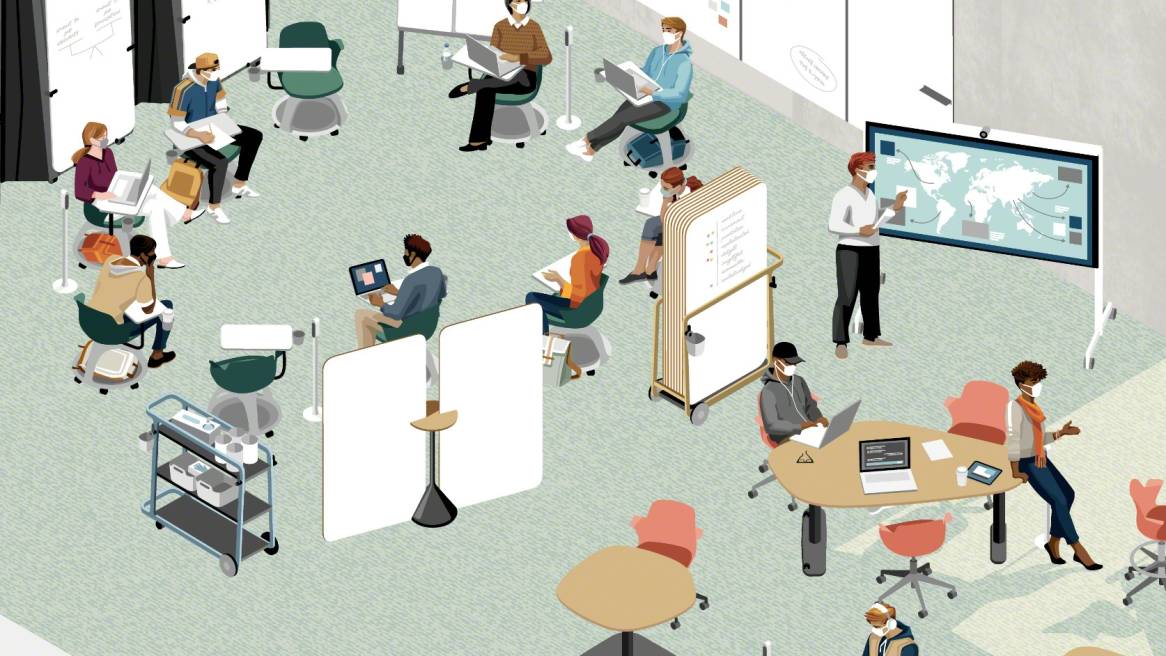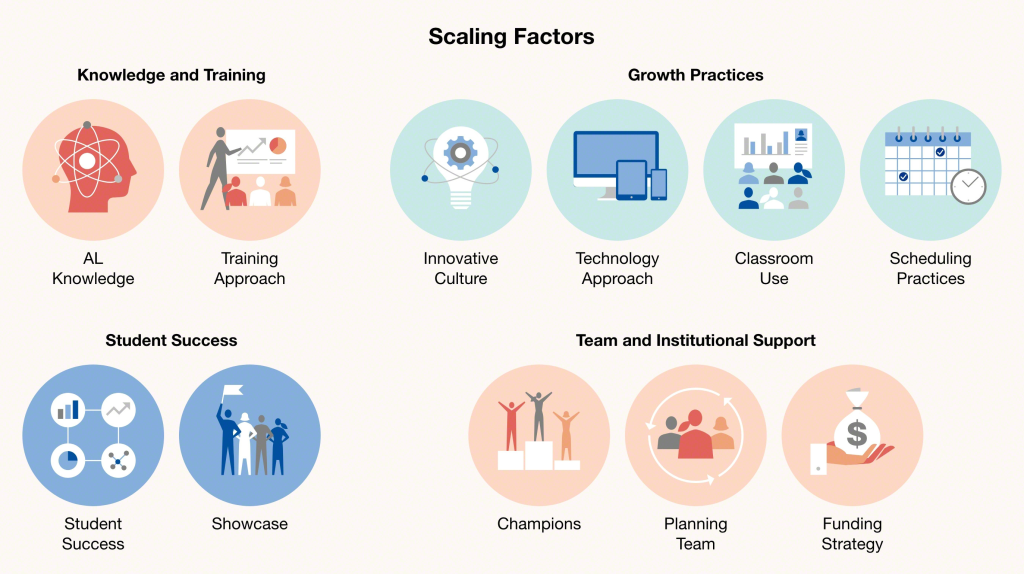Why & How to Grow Active Learning: A Leader’s Guide
It’s a big idea. But it’s not a new idea.
Already back in 1852, at least one thought leader, John Henry Newman, asserted that true learning “consists, not merely in the passive reception into the mind of a number of ideas hitherto unknown to it, but in the mind’s energic and simultaneous action upon and among those new ideas.”
Why then is learning still stagnant in so many of today’s schools, colleges and universities, while others are successfully embracing active learning and rapidly growing their investments in its methods and learning spaces?
According to recent Steelcase research involving 34 schools ranging from kindergartens to universities, the overarching denominator of success is leadership — specifically, administrative leaders who fully recognize and promote the purpose and value of active learning. These change champions realize active learning is about more than just the trendy ideas of some teachers. Instead, they recognize active learning has a much bigger part to play, effectively tackling some of their institution’s biggest challenges and the most demanding metrics they face.
“All schools are driven by various success factors,” observes Sharon Beaudry, an experienced educator who conducted this research project as a Steelcase Fellow. “It might be enrollment. It might be retention. It might be graduation rates, testing scores or engagement metrics. And increasingly, schools are incorporating active learning as part of the formula in achieving these goals.
“One of the most important findings from this research is that leaders at schools where active learning is successfully growing have been able to tie it directly to a range of success factors. Because of that, it has become an important part of their strategy for addressing key goals for their institution.”
Of course, no leader can do it alone. At the same time, without administrative leaders as its proponents, significant growth of active learning at an institution is essentially impossible. By providing vision, guidance and empowerment to cross-functional teams, leaders are irreplaceably important for making change happen.
Significant Variances
Of the 34 schools included in the research, 97% had little to no previous exposure to active learning classrooms. After receiving an active learning classroom through Steelcase’s grant program, 25% became what Beaudry terms “high-flyers”— schools that invested in an average of 30 more active learning classrooms after receiving their grant. An additional 22% of the schools were “progress makers” with growth of 10-20 more active learning spaces at their institutions. In contrast, more than 50% — the “well-meaning teams” — achieved very little or no growth, despite the best efforts of advocates.
Why such a range of difference? What insights can be gained from this research to benefit other institutions hoping to successfully seed and nurture active learning? How can active learning go beyond isolated occurrences in just a few classrooms to becoming a norm throughout an entire institution? Those were among the questions this research focused on answering.
Uncovering the Growth Factors
Analysis of the synthesized research revealed 11 key factors that are fundamental for successfully growing active learning in any type of institution:
Knowledge and training
Active learning knowledge: Make the benefits and outcomes of active learning widely known and understood, within and beyond the teaching staff.
Multiple training methods: Transitioning to active learning can be challenging for educators. Develop systematic, institutional approaches to training, including incentives, to ensure widespread cultural change.
Growth practices
Innovative culture: Motivate a majority of staff to embrace active learning versus sticking with traditional methods and approaches. In successful schools, staff were excited to cross thresholds and be part of the journey toward more progressive learning.
Standardized technology approach: Avoid overloading active learning classrooms with complicated technologies. Instead, take a standardized, user-centered approach. In addition to easier adoption, this approach avoids giving active learning a reputation within the school of being too complex or a pricey investment for only a privileged few.
General classroom use: Don’t limit your grant-provided active learning classroom to just one department or one educator. Instead, ensure it is used in rotation by multiple classes and educators, extending the experience broadly and laying a foundation for growth.
Priority scheduling: Assign active learning classrooms only to educators with active-learning training, reducing the risk of use for lecture-based classes — a waste of both learning opportunities and resources.
Success metrics
Tied to student success factors: Tie active learning to student success factors and incorporate it into your overall strategy and facilities master planning efforts.
Showcase marketing: Showcase active learning spaces to generate internal and external enthusiasm and enhance recruitment efforts, recognizing that expectations for more active learning are accelerating from kindergarten on.
Team and institutional support
Leadership champions: Leaders who maintain a rigorous focus on active learning and inspire others to become its torchbearers play a monumental role in the success of active learning. In contrast, without leaders’ enlightenment and involvement, the facilities team often blocked efforts to proliferate active learning spaces.
Multifunctional planning team: Involve multifunctional teams. Ideally these include people in administration, teaching, IT, facilities and procurement. Less successful schools have a narrower, top-down approach, often limited to facilities and finance.
Funding strategy: Create a planned funding approach for active learning growth, tying it directly to student success metrics and the strategic plan versus relying on grants or remnant departmental funds.
Assuring Impact
Paying attention to only a few of the growth factors while ignoring the others will rarely lead to success, emphasizes Beaudry; it’s the combination of factors that makes the difference. That said, the research underscores the necessity of buy-in and involvement from leaders.
“Time and again, throughout all of these different factors, we could see that it’s the leader that is able to pull the levers to make this happen in a meaningful way,” she notes. “But they can’t — and shouldn’t — do it alone. That can too easily backfire as a heavy-handed, top-down approach. But when you get leaders involved and they’re bringing in a team of people with multiple voices heard, that’s what really drives successful active learning initiatives.”
Steelcase welcomes the opportunity to share more about this study and to help higher education and K-12 schools adopt these factors for successful growth of active learning and active learning classrooms. We can help schools leverage current resources to make cultural shifts and develop institutional strategies to grow active learning. Complete this short form to learn more by being connected with an education specialist.
About the researcher
Sharon Beaudry is associate professor of management at Oregon Institute of Technology and has two decades of prior experience as an administrative leader in higher education and nonprofit settings. Her academic scholarship focuses on active learning and active learning spaces. She conducted this research as a 2020-2021 sabbatical project, serving as a Steelcase Learning Research Fellow.
About the research
- Subjects were former Steelcase Active Learning Center grant recipients
- Research included 47 interviews with faculty, administrators and leaders at 32 higher education & 11 K-12th grade schools across the United States
- Both public and private schools were represented, as well as a wide range of enrollments
- 97% had no active learning classrooms prior to the grant




